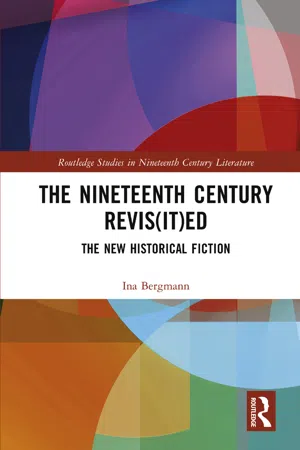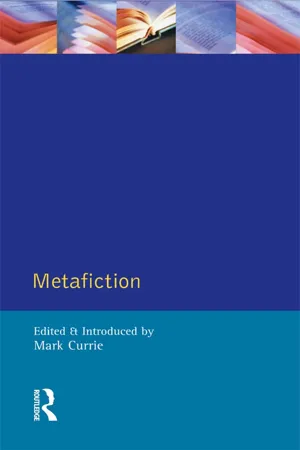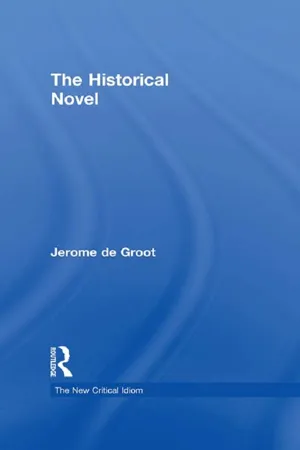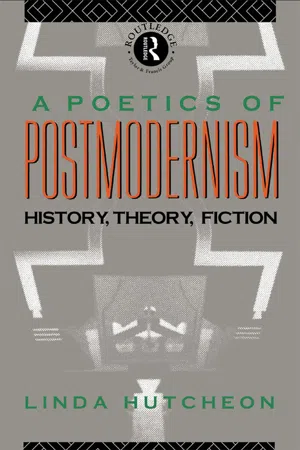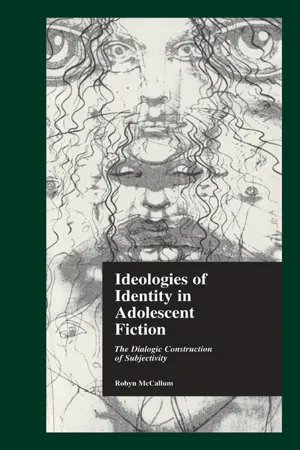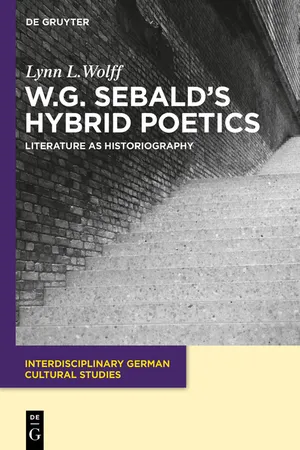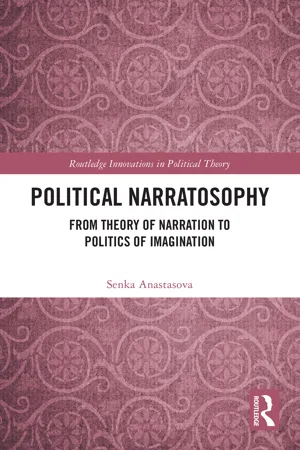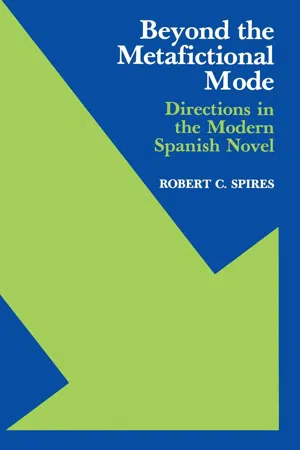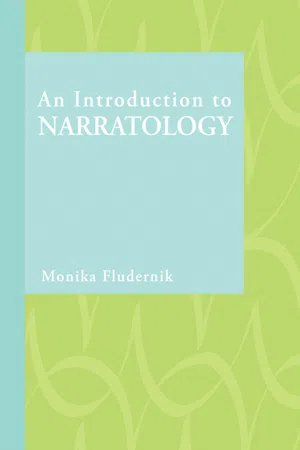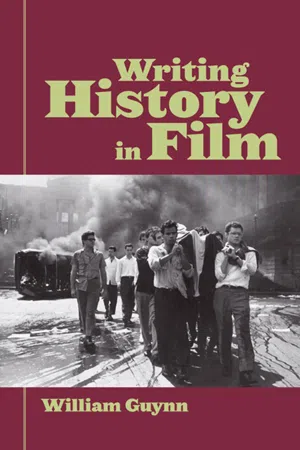Literature
Historiographic Metafiction
Historiographic metafiction is a literary technique that blurs the lines between history and fiction, often by incorporating historical events, figures, or texts into a fictional narrative. It challenges traditional notions of historical truth and explores the ways in which history is constructed and interpreted. This approach encourages readers to critically engage with the relationship between history and storytelling.
Written by Perlego with AI-assistance
Related key terms
12 Key excerpts on "Historiographic Metafiction"
- eBook - ePub
The Nineteenth Century Revis(it)ed
The New Historical Fiction
- Ina Bergmann(Author)
- 2020(Publication Date)
- Routledge(Publisher)
Metahistory (1973), which recognizes the “historical work as … a verbal structure in the form of a narrative prose discourse” (2), they provide the following description: “By ‘metahistorical’ we mean those works of both fiction and nonfiction in which one of the author’s primary contentions is the process of historical narrative itself” (Heilmann/Llewellyn 2).Hutcheon’s term “Historiographic Metafiction” provides such a combination and suggests that such writingrefutes the natural or common sense methods of distinguishing between historical fact and fiction. It refuses the view that only history has a truth claim, both by questioning the ground of that claim in historiography and by asserting that both history and fiction are discourses, human constructs, signifying systems, and both derive their major claim to truth from that identity.(Poetics 93)In the preface toHistoriographic Metafiction in Modern American and Canadian Literature (1994), Bernd Engler und Kurt Müller define Historiographic Metafiction similarly:The post-modern state of consciousness is reflected in the historical novel in numerous and manifold forms of literary self-reflexivity. The use of metafictional narrative techniques that thematize the processuality of writing and the fabricatedness of our mental representations of reality is a prime example of literary self-reflexivity. Post-modern consciousness can also be found in playful, reciprocal superimposition of historiographic and literary discourse, which illustrates to what extent the construction of historiographic plausibility and coherency depends on the use of archetypal narrative “models of world-making.” (9)It is Hutcheon’s further claim “that postmodernists play with history and create a potentially subversive form of cultural critique” (Elias, Sublime xix; see also Kunow, “Making” 195). Historiographic Metafiction is “the most prominent expression of the postmodern attack on the traditional view of art as a realistic or mimetic representation of reality” (Engler 13). Since the publication of Hutcheon’s The Poetics of Postmodernism - eBook - ePub
- Mark Currie(Author)
- 2014(Publication Date)
- Routledge(Publisher)
Part TwoHistoriographic Metafiction
Passage contains an image
4 Historiographic Metafiction *
LINDA HUTCHEONWhereas ‘radical metafiction’ belongs to a late stage of modernism, for Hutcheon, the meeting of metafiction and historiography produces a new kind of experimental writing uniquely capable of fulfilling the ‘poetics of postmodernism’. In this chapter of her A Poetics of Postmodernism Hutcheon discusses the ways in which historiographic meta-fictions have redefined the relationship between literature and history, specifically by challenging the separability of the two discourses. Against Paul de Man and the deconstructionist conflation of fact and fiction, Hutcheon argues that Historiographic Metafiction points to the continuing relevance of that opposition at the same time as it highlights discursive principles common to both. Readers of historiographic emetafiction will respond to historical material in such novels with a double awareness of its fictionality and its basis in real events, thus entering into one of postmodernism's definitively unresolved contradictions.The discussion here places such writers as Salman Rushdie, Robert Coover, Christa Wolf, Julian Barnes, John Fowles and Umberto Eco in the context of an ongoing debate between history and fiction, particularly as it has been transformed by the historiographical skepticism of Hayden White and Dominick LaCapra, the non-fictional novels of Hunter S. Thompson, Tom Wolfe and Norman Mailer, and a post-Vietnam distrust of official versions of contemporary history. In this context, the importance of historiographical metafiction is defined in terms of its ability to contest the assumptions of the ‘realist’ novel and narrative history, to question the absolute knowability of the past, and to specify the ideological implications of historical representations, past and present.I
We theoreticians have to know the laws of the peripheral in art. The peripheral is, in fact, the non-esthetic set. It is connected with art, but the connection is not causal. But to stay alive, art must have new raw materials. Infusions of the peripheral. - eBook - ePub
- Jerome De Groot(Author)
- 2009(Publication Date)
- Routledge(Publisher)
Is there a relationship between the historical novels of Scott and the fictions of postmodernism? Certainly there has been a shift in conceptualisations of ‘History’ itself, and the purposes and virtues of such a style of writing. Postmodern writings using the past may not strictly be ‘historical novels’ but they are a highly influential way of meditating upon history through fiction, and as such they demand our attention. What, particularly, Hutcheon and Waugh point out is that from the 1960s onwards the mode of writing fictional histories shifted (Hutcheon 1988: 115). For Hutcheon the key elements of Historiographic Metafiction are its ability to implement provisionality and problematise knowledge:The interaction of the historiographic and the metafictional foregrounds the rejection of the claims of both ‘authentic’ representation and ‘inauthentic’ copy alike, and the very meaning of artistic originality is as forcefully challenged as is the transparency of historical referentiality.(Hutcheon 1988: 110)Such types of fiction emphasise intertextuality, contradiction, self-consciousness and problems of narrative. The form ‘destabilizes received notions of both history and fiction’ (Hutcheon 1988: 120). For Waugh, metafiction demonstrates that the novel as a form has become aware of its own innate artificiality, that it is a construction of a type of reality:Indeed, it could be argued that, far from ‘dying’, the novel has reached a mature recognition of its existence as writing, which can only ensure its continued viability in and relevance to a contemporary world which is similarly beginning to gain awareness of precisely how its values and practices are constructed and legitimized.(Waugh 1984: 19)This self-consciousness, relatively shorn from its radical roots, is now a commonplace in fiction (see Chapter 4 - eBook - ePub
A Poetics of Postmodernism
History, Theory, Fiction
- Linda Hutcheon(Author)
- 2003(Publication Date)
- Routledge(Publisher)
For Barthes, the same illusionary elision is also present in realist fiction. What Historiographic Metafiction does is reinstate the signified through its metafictional self-reflexivity about the function and process of meaning-generation while at the same time not letting the referent disappear. Such postmodernist fiction, however, also refuses to allow the referent to take on any original, founding, controlling function: Ezra Pound is made to meet Hugh Selwyn Mauberley. The facts of history, as portrayed in Historiographic Metafiction, are overtly discursive. Often this is formally and thematically worked out within the narrative itself: think of the different and contradictory “factual” (in this sense of the word) accounts of the same events in The Temptations of Big Bear or Antichthon. It is one of the lessons of postmodernism that, while all knowledge of the past may be provisional, historicized, and discursive, this does not mean we do not make meaning of that past. III Language is…more powerful as an experience of things than the experience of things. Signs are more potent experiences than anything else, so when one is dealing with the things that really count, then you deal with words. They have a reality far exceeding the things they name. William Gass Facts versus events: how language hooks onto reality. The questions raised by Historiographic Metafiction regarding reference in language (fictive or ordinary) are similar to those raised by these theoretical discourses today. John Banville’s Doctor Copernicus focuses directly on the relations between facts and events or, more specifically, between names and things, scientific theories and the universe. And the intertextual allusions to Wittgenstein in the novel point to the broad implications of this theme. In Coetzee’s Foe, it is Robinson Cruso’s [sic] tongueless Friday who is the focus of the question of the relation of language to reality - eBook - ePub
Ideologies of Identity in Adolescent Fiction
The Dialogic Construction of Subjectivity
- Robyn McCallum, Jack D. Zipes, Jack D. Zipes(Authors)
- 2012(Publication Date)
- Routledge(Publisher)
1 It is the self-reflexive incorporation of the discursive and textual styles of history writing, rather than their actual historicity, that is characteristic.History writing constitutes, in Bakhtin’s terms, a discursive genre: it is characterized by particular structural and linguistic forms for assimilating and representing aspects of reality; and it is inscribed with particular cultural and ideological assumptions about knowledge and understanding. In conventional historical fiction, historical discourse is treated as if it were transparent, that is, as if the object of representation (past events, persons and settings) could be unproblematically made present independent of the discourses and narrative structures used to represent it. Metafictive novels retain the documentary status and generic conventions of incorporated historical documents, thus drawing attention to the discursive conventions of both historical and fictive writing, to their role in representing and ascribing meanings to events, characters and objects, and hence to their lack of transparency. In metafictive novels such as Backtrack (Hunt, 1986 ) and Strange Objects (Crew 1990/1991 ), historiographic material is incorporated in ways which destabilize the relations between history and fiction and represent the narratorial subject as decentered and fragmented. The representation of subjectivity in Historiographic Metafictions is a special case and, as I will argue, the outcome can be very different in different texts. In general, the textual strategies of Historiographic Metafictions can construct positions from which to interrogate the conventional authenticating functions of historical material in fiction and the processes by which we understand and interpret historical discourses. In the next section, these ideas will be illustrated through a comparison of the ways in which historical material and discourse are incorporated in two conventional historical novels The Devil’s Own (Lisson, 1990 ) and Mandragora (McRobbie, 1991 ), with their incorporation in two metafictive novels, Strange Objects and Backtrack - eBook - ePub
- Lynn L. Wolff(Author)
- 2014(Publication Date)
- De Gruyter(Publisher)
159Whether we talk of Historiographic Metafiction or metahistorical novels, these forms are not the only ones that have a privileged access to the (re)construction of the past in the twentieth century. Ankersmit describes a “personalization or privatization of our relationship to the past,” which is manifested in the “sudden predominance of the notion of memory” in twentieth-century historical representation.160 Aleida Assmann points to the separation of history from memory that occurred alongside the professionalization of the discipline of history in the nineteenth century as well as the way the two have begun to converge again since the 1980s.161 Oral history has played a significant role in this development and is relevant to the discussion at hand, for it is a form of historical investigation that reveals both a desire for more immediate access to the past and an awareness of the role human influence plays in the construction of the past.162 Assmann points to the connection between oral history and Holocaust research in particular, namely the revaluation of survivor testimonies, highlighting how such forms of witnessing both document the past from an intimately personal perspective and serve a memorial function.163 In a similar vein to oral history, “Alltagsgeschichte,” or history of the everyday, has been an important development in reconsidering the role of personal memory in official forms of historiography. Andrea Albrecht highlights how historians of the everyday undertake microhistorical investigation of letters, memories, and interviews of contemporary witnesses, referring to Christopher Browning’s Ordinary Men as a significant contribution to the development of this methodology.164 - eBook - ePub
Political Narratosophy
From Theory of Narration to Politics of Imagination
- Senka Anastasova(Author)
- 2023(Publication Date)
- Routledge(Publisher)
Thus, the search is once more for the configurative affinity between the structure of fiction and historiography. This brings the possibility of questioning the past. That further points to the bond between narrativity and referential reality through at least three hypotheses: The first hypothesis activates the poetic language which transports experience and points its horizon towards the world in which it exists; The second is about the fusion of horizons (Horizontverschmelzung/ Gadamer) of the world of the text and the world of the reader is the second starting point; the third hypothesis locates the problem of reference of the narrative discourse in the asymmetry of the referential modes of historiography and fiction. Such referential dynamics of historiography unavoidably contain the appearance necessary for the historiographic text, to reconstruct the past. According to this logic, this discourse relies on the reference accomplished through metaphor, in the same amount in which fiction uses reference-based clues in the name of the goals of metaphor. This is a refiguration that implies alteration, a transformation of reality. It is first refigured in the consciousness of the writer, it is then configured in the text as narratological strategy, and then it is reshaped in the virtual experience of the cognition which happens during the process of reading, during the crossing of the horizon of the text with the horizon of the reader. 3 Such a process is enabled by following the hybridization and modification of the documentary in fiction, or Historiographic Metafiction (Hutcheson). Political narratosophy understands this poetically theoretical category at the level of historiography that is specified through the metafiction, i.e. one that includes the correlation of history-historiography-fiction-historical genre. Historiographic Metafiction suggests that the past exists, but our relation to it semiotically transforms - eBook - ePub
Studies in Romance Languages
Directions in the Modern Spanish Novel
- Robert C. Spires(Author)
- 2021(Publication Date)
- The University Press of Kentucky(Publisher)
Yet for my own purposes as a teacher and critic I have found that none of the studies is quite adequate to the task of drawing the limits to what reasonably should and should not be labeled metafiction. Alter, for example, says that a self-conscious novel deliberately exposes the artifice of fiction, which is not to be confused with an elaborately artful novel where the artifice may be prominent. Such a differentiation might be useful if some formula were provided for deciding how “prominent” the artifice must be before it is considered “deliberately exposed.” Although Scholes’s approach is patterned on formalist-structuralist concepts, his definition of metafiction as a work assimilating all the perspectives of criticism into the process itself of fiction is, if anything, even more open-ended than that of Alter. And Pérez Firmat’s “narration-gloss of the narration” formula would seen to allow every novel with an intrusive narrator to qualify as metafiction, while the reliance on allegory for his “narrative metafiction” category threatens to make the term all-inclusive. Even Hutcheon’s diegetic versus linguistic categories, which are broken down into overt and covert subcategories, tends to expand the application excessively. Finally, Christensen hardly leads us beyond the now standard definition of metafiction as a novel about itself, a definition that is fine in the most obvious examples where a character or narrator discourses about the nature of novels in general, but inadequate when it is a question of deciding if more subtle and complex techniques qualify as novelistic self-commentary. As a step in the direction of plotting where the limits might be drawn, I have adopted a linguistically grounded approach focused on the concept of modes - eBook - ePub
Contested Transparencies, Social Movements and the Public Sphere
Multi-Disciplinary Perspectives
- Stefan Berger, Dimitrij Owetschkin, Stefan Berger, Dimitrij Owetschkin(Authors)
- 2019(Publication Date)
- Palgrave Macmillan(Publisher)
The provisional nature of fictive language allows it both its imaginative freedom and its claim to truth”. 76 Such a text thus playfully directs the readers’ attention to language and, in turn, to the question of meaning and the very impossibility of fixing it. In that sense and in spite of its alleged autonomy, it does represent the world, but, as Roland Barthes has it, it “represents it as a question – never, finally, as an answer”. 77 Thus, metafiction, arguably by means of a complex interplay of transparency and intransparency, does not resort to a mimetic mode of representation, since this, to put it in Walsh’s words, “is not conceived of as the primary vehicle of [the text’s] engagement with the world”. 78 At the very same time, however, it invites the reader to re-establish just this relationship between text and world, which is thus simultaneously weakened and strengthened. 79 Metafiction generally, as Mark Currie has noted, almost inherently makes the reader an active participant in the process of the constitution of meaning. In order to do so, it frequently makes transparent not only the act of narration but also that of reading, incorporating into the text “a kind of surrogate author grappling with his ability as a storyteller and with the ability of words to communicate […] experience” as well as “a surrogate reader trying, as protagonist […] to make sense of events and to interpret [their] significance in a manner analogous to that of the external reader”. 80 Metafiction thus “internalizes the relationship between authors and readers, fiction and criticism, art and life” 81 and can thus be seen as a privileged vantage point from which to reflect on a number of further problems inherent to fiction in general: the relationship between literature and external reality, text and world, between perception and representation, between language and reality, between history and story, between text and reader - eBook - ePub
Realism and Power (Routledge Revivals)
Postmodern British Fiction
- Alison Lee(Author)
- 2014(Publication Date)
- Routledge(Publisher)
If you don’t know what’s true or what’s meant to be true, then the value of what isn’t true or what isn’t meant to be true becomes diminished” (Barnes 1984: 77). In “Ricks’” terms, then, the literariness of the text can only be recognized in opposition to the factual, and the factual would seem to be seen here as extratextual. The presence of factual or documentary information in metafictional texts often seems to validate fictional events, as it does in Scott’s novels. In John Fowles’ The French Lieutenant’s Woman, for example, Charles works in the same library as does Karl Marx, and Sarah Woodruff lives with the Rossettis. Similarly, in Timothy Findley’s Famous Last Words, Hugh Selwyn Mauberley meets Ezra Pound as well as the Duke and Duchess of Windsor. These fictional characters, then, are given the same ontological status as the “real” characters. Equally, however, the “real” characters who exist or existed are fictionalized: they both are and are not the entities who are designated by their names. Their ontology, thus, is called into question, as it is even more radically in Midnight’s Children by Salman Rushdie. In “Historical Discourse,” Roland Barthes argues that “the only feature which distinguishes historical discourse from other kinds is a paradox: the ‘fact’ can exist linguistically only as a term in a discourse, yet we behave as if it were a simple reproduction of something on another plane of existence altogether, some extra-structural ‘reality.’ Historical discourse is presumably the only kind which can aim at a referent ‘outside’ itself that can in fact never be reached” (1970: 153). But, the same can be said of the historical discourse in historiographie metafiction. In Midnight’s Children, as in Waterland, historical events and people are combined with magic and fantasy - eBook - ePub
- Monika Fludernik(Author)
- 2009(Publication Date)
- Routledge(Publisher)
fictum, and that truth in the historical or practical sense of the word can only be generated in context by comparison with other information. The fact that objects, people and places actually exist cannot be adduced from the text alone but must be supported by evidence from the context and other sources of information.Metafiction and metanarrationAt this point it might be helpful to clarify two concepts that are often used in connection with postmodern texts and are frequently regarded as signs of anti-realism: metanarration and metafiction. We should note, to begin with, that these terms are often treated as identical in meaning, particularly in the English-speaking world. Metanarrative narratorial comments are widely seen as evidence of fictionality and so they are often considered to be instances of metafictionality. Such an equivalence cannot be taken for granted, however. On the contrary, metanarrative comments can considerably strengthen the illusionistic effect of a realistic narrative, as Ansgar Nünning has pointed out (Nünning 2004).Metanarrative narratorial comments are to be found in texts dating from long before the twentieth century; indeed, they already existed in the Middle Ages. In conversational narrative, the so-called abstract can be counted as a metanarrative comment on the part of the storyteller, for example: ‘Have I already told you about the time when the parrot came and perched on my head?’ Metanarrative statements fulfil a wide variety of functions, most of them hardly noticeable as the phrases are so short, like the verb ‘told’ in the example above. Many purported metanarrative sections of narrative are actually metadiscursive (Fludernik 2003b, Engler 2004). They help readers to orientate themselves on the discourse level (‘as we saw above’ and ‘as we shall see in the next chapter’) and to shift their attention from one location or group of people to another more easily (‘We shall therefore see a little after our hero’, Joseph Andrews - eBook - ePub
- William Guynn(Author)
- 2013(Publication Date)
- Routledge(Publisher)
But the reality is, Marrou tells us, that few historians are inclined to take such a critical approach to their own work; most act as if historical research were a rigorous method that can be applied in unproblematic fashion. Theoretical problems like subjectivity are put out of mind and relegated to the domain of philosophy of history, whose abstractions remain disconnected from actual historical practice.FICTIONAL STORIES AND HISTORICAL NARRATIVESA second blind spot for historians is the narrative character of historic discourse. Historians have generally resisted acknowledging that historical explanation takes place through the process of narration; they work, rather, on the implicit assumption that history is a discourse sui generis that scientific practice has separated from literary discourses. This assumption would not remain unexamined. In an article published in 1967, Roland Barthes called into question the notion that history is a specific kind of discourse, basing his critique on the methods of the emerging field of semiology. He argued that structural linguists who apply linguistic methods to the analysis of discourses should not concern themselves exclusively with universal discursive characteristics but should examine the accepted categories of discourse called genres in order to determine whether or not there is a linguistic basis for distinguishing between historical and fictional forms of narrative:Is there in fact any specific difference between factual and imaginary narrative, any linguistic feature by which we may distinguish on the one hand the mode appropriate to the relation of historical events—a matter traditionally subject, in our culture, to the prescriptions of historical “science,” to be judged only by the criteria of conformity to “what really happened” and by principles of “rational” exposition—and on the other hand the mode appropriate to the epic, novel or drama?8Moreover, Barthes is critical of the notion of the fact, which presumably preexists the historian’s act of narration as an autonomous element within the field of reference. Citing Nietzsche, he observes that a fact does not exist already formed; it is produced as a result of “introducing meaning,” of integrating the “fact” as an element of human discourse about the past. Barthes is equally critical of the passive position historians claim to assume: it is as if they wrote under the dictate of past events, where facts are givens and discursive structures inhere in the material the historian is studying. The myth of the ascendancy of the referent obscures, Barthes argues, the properly linguistic character of historic narration. Why is it, he asks, that history is able to do away with the production of meaning that semiology discerns in every form of human communication? Such a conception would reduce the tripartite character of the sign to two terms: the signifier and the referent. Eliminating the signified, the language of historic discourse would directly express the real:
Index pages curate the most relevant extracts from our library of academic textbooks. They’ve been created using an in-house natural language model (NLM), each adding context and meaning to key research topics.
